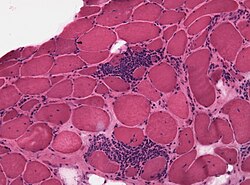Tropical spastic paraparesis
Tropical spastic paraparesis or HTLV-I-associated myelopathy (HAM) is a disease that affects the spinal cord and nerves going to the legs. It is caused by infection by the HTLV-1 virus. The disease is sometimes called Tropical Spastic Paraparesis (TSP). Symptoms of the disease may include: leg weakness, back pain and urinary dysfunction. The symptoms are often similar to those of multiple sclerosis.
The beginning of the disease is often slow, and symptoms are not noticed for some months or years. About 5-10 million people around the world have been infected with HTLV-1. Two percent of them may develop HAM. This means that HAM is a rare disease.
There is no cure for HAM, although people can live for many years with the symptoms. Sometimes the symptoms get worse. In other cases, people's symptoms stay stable. Treatment of the disease is focused on relieving the symptoms,[1] and it is important to stay as active as possible.
There are higher numbers of people with HAM in southwest Japan, Central, and South America, Asia, central Australia, and Romania. These are areas where HTLV-1 is more common.[2][3]
Tropical Spastic Paraparesis Media
References
- ↑ "HTLV-1 associated myelopathy/tropical spastic paraparesis". NORD (National Organization for Rare Disorders). Retrieved 2022-11-28.
- ↑ Saito, Mineki (2019-05-15). "Association Between HTLV-1 Genotypes and Risk of HAM/TSP". Frontiers in Microbiology. 10: 1101. doi:10.3389/fmicb.2019.01101. ISSN 1664-302X. PMC 6529560. PMID 31156605.
- ↑ Sharma, Ruchika (2022-12-21). "Daiichi Sankyo unveils Blood cancer drug EZHARMIA in Japan". medicaldialogues.in. Retrieved 2022-12-22.

